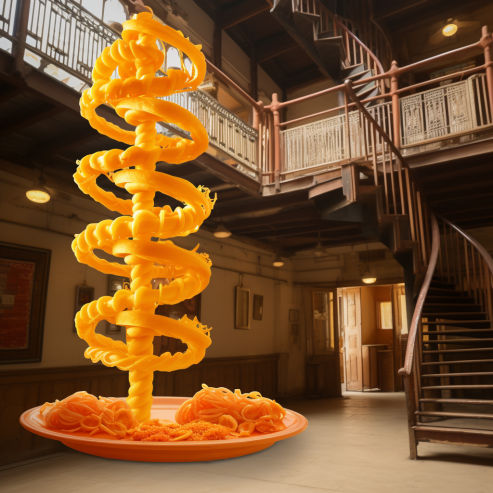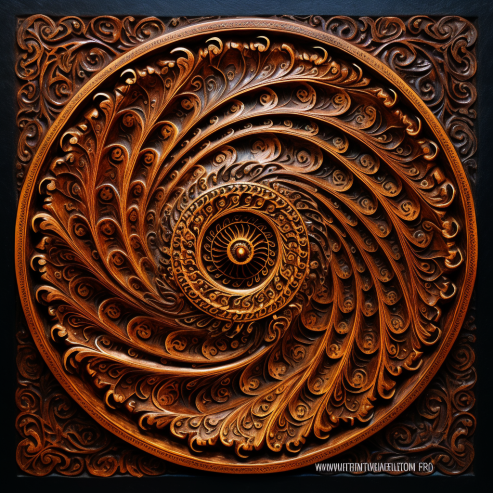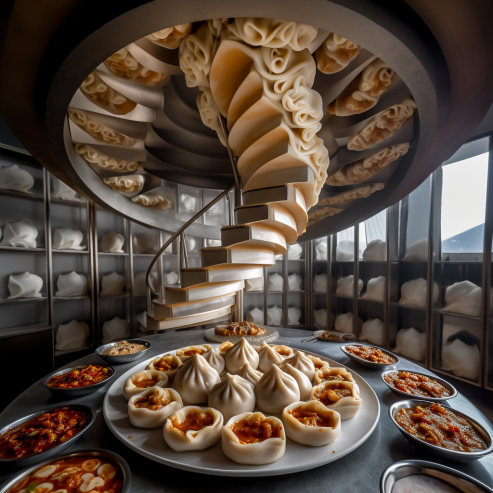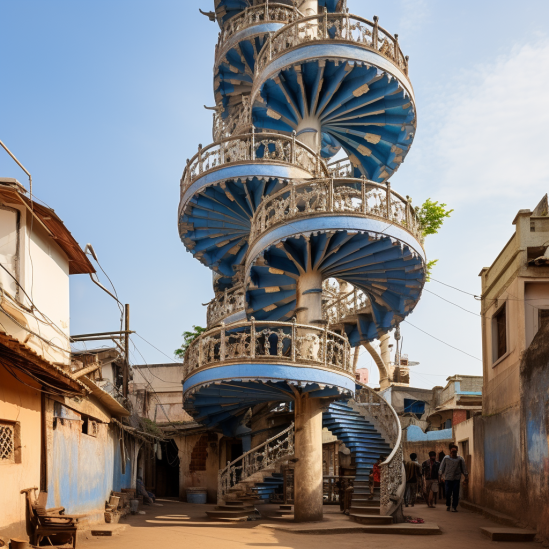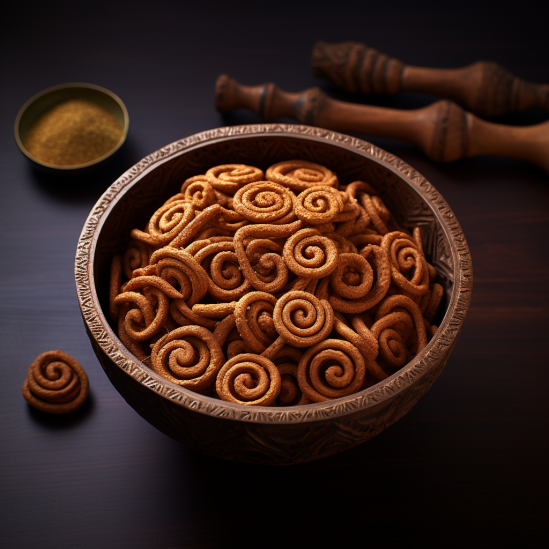Staring at a rotating spiral pattern produces a hypnotic effect; perhaps that’s why so many of our regional snacks – fried and sweet – adopt this circular form: It’s nothing more than a sales strategy – to get you to eat more.
Whether you purchase these snacks vacuum packed from a supermarket or eat them fresh off the street side stalls, the bottom line is that we’re all being hypnotised by the makers of these delicious devils in the form of spiced, savoury, and syrup-soaked snacks, prevalent in almost every Indian state.
Across India, we snack on chaklis, deep-fried spikey spirals made from gram flour, rice flour, or lentil-based flours. The sweet, spicy and tangy bhakarwadi is a traditional Maharashtrian, Rajasthani, and Gujarati farsan filled with a combination of cumin, sesame, poppy, and coriander seeds with coconut and peanuts. Crisp, juicy and brightly coloured jalebis are a celebratory staple and the flakey, moreish Malabar parotta made in Kerala and Tamil Nadu are the perfect carriers for soaking up mouthwatering curries. On a recent visit to one of Mumbai’s khau galis, I noticed more than one street vendor selling an Instagram-favorite: Tornado Potatoes, a South-Korean street snack made with a carefully cut whole potato, spiralled on a skewer, creating a tornado or twister shape.
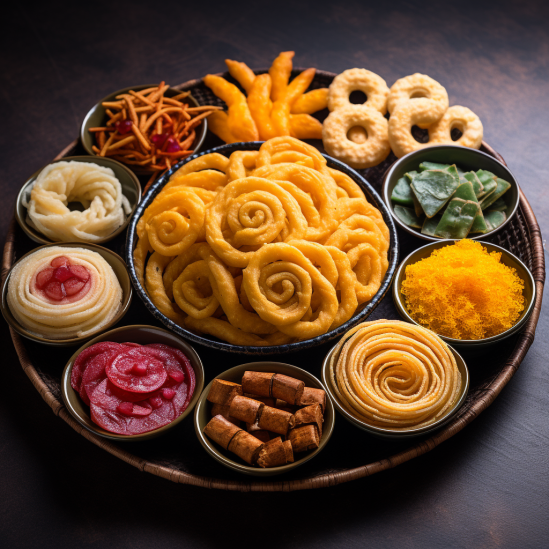

As an architect (of buildings) who has been working with food for over a decade now, seeing this 3-D spiral IRL really got me thinking. I have been working with food as the subject of my design projects since the beginning of my architecture education: I created a hanging structure made of candy and marshmallows, suspended on a thin wire frame – to be eaten, in my first year; I exhaustively researched Mumbai’s tea culture and mapped out the entire tea ecosystem in order to design sensory tea candles – modelled after Mumbai’s iconic cutting chai; My dissertation titled ‘Gastronomy and Architecture: Multisensory Experiences’ demonstrated how gastronomy and architecture are both artistic disciplines stemming from the basic needs of nutrition and shelter respectively, and how workflows involved in both disciplines run parallel to each other.
There exist several similarities between gastronomy and architecture. All buildings are like cookery, in the sense that they make use of raw ingredients from the earth and combine them in acceptable combinations, synthesising them into a product greater than the sum of their individual parts. In cooking, we call this a meal, in architecture, a building. We follow recipes or blueprints, and aim to satisfy consumers and users respectively. Recipes often begin with cutting, grinding, chopping, and sifting, and so does building construction. Cookery, like construction, takes nature and makes it into culture.
Spirals are a common shape found in the natural world. We find spirals in the DNA double helix, weather patterns (including hurricanes), vine tendrils, galaxies, the horns of various animals, snail shells, and ferns. Look at a cross section of red cabbage and you will see spirals. Look at your fingertip, where you would make a fingerprint, and you will see a spiral. Even the shape of your hair at the crown of your head… a spiral. Spirals seem to permeate many diverse natural formations: inorganic and organic, lifeless, and alive, non-conscious and conscious. From an architecture perspective, the space-saving and aesthetic spiral staircase comes to mind. A spiral staircase turns around a central axis and rises as it goes around. Just like the Tornado Potato I had in my hand.

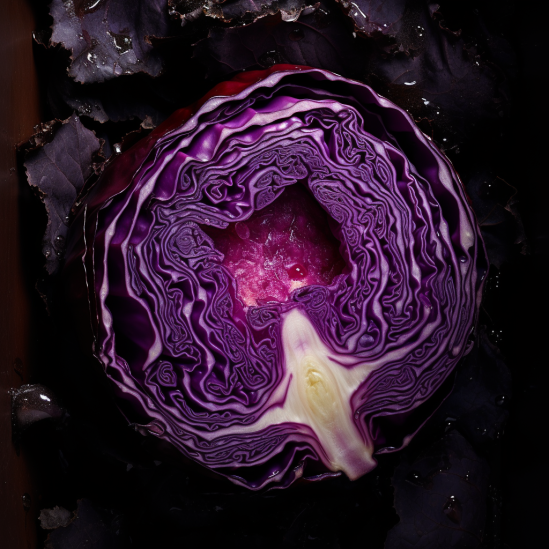
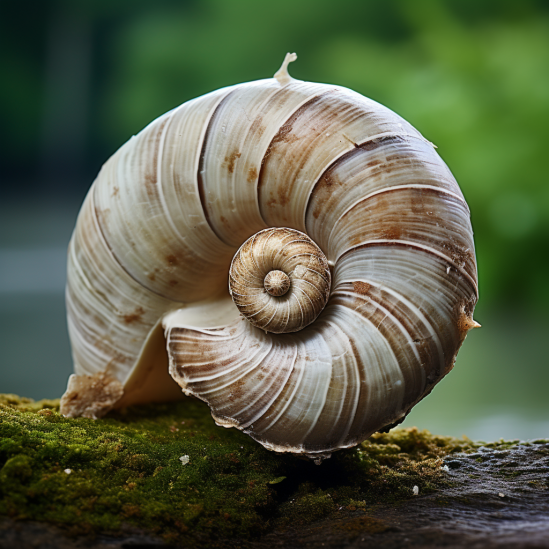

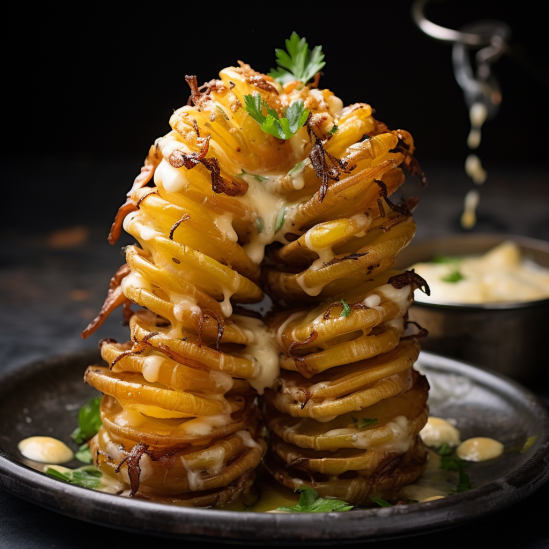
When it comes to our snacks, this spiral shape is often a result of both practical and sensory considerations. A lot of what our food looks like is because of how it is prepared (think chaklis, Malabar parottas and jalebis), or portioned and served (think bhakarwadis, patra, khandvi and pootharekulu – a popular Andhra sweet consisting of paper sheets made from rice batter).
Here are some likely reasons why so many of our favorite snacks are spiral in shape:
Enhanced Texture
The spiral shape creates a unique texture that contributes to an enjoyable eating experience. The ridges and curves of spiral snacks can provide a satisfying crunch or a chewy bite, depending on the snack’s ingredients and preparation process.
Increased Surface Area
The spiral shape increases the surface area of the snack, which can amplify the flavors and seasonings. More surface area means more seasoning (or sugar syrup) can adhere to (or soak into) the snack, resulting in a more intense taste experience.
Structural Stability
Spiral shapes provide structural stability to the snack, making it less likely to break during production, packaging, shipping, and handling. The spirals help prevent the snack from crumbling or shattering too easily, unlike fragile and planar potato chips and khakras.
Visual Appeal
The spiral shape is visually attractive and stands out on store shelves and street stalls, which can make the snacks more appealing to us consumers. Attractive packaging and shapes can influence us to purchase (and consume) more.
Marketing Strategy
Some snack manufacturers create unique and fun shapes to differentiate their products from competitors. The novelty of spiral-shaped snacks can draw the attention of consumers and encourage them to try something new. Think of the hypnotic spirals of Mongini’s colorful cream cakes, cassata ice cream and good old Snowman’s iconic chic-choc topped with chocolate sauce and roasted nuts.
Finger-friendly
The spiral shape often makes snacks more convenient to eat. Spiral shapes can be held between fingers easily, allowing for a mess-free snacking experience.
Variability in Taste
Due to the spiral shape, the flavour intensity may vary as you consume the snack, providing a mix of tastes and textures as you move through each spiral loop. Bhakarwadis are a good example of this.
I wonder what’s next in store for our spiral snacks beyond the potato staircase on a stick. The verdict? Tornado potatoes can stay on my Instagram feed, pink Barbie jalebis are all I need.

To keep the whirlwind going, Team enthucutlet brings you a host of lesser known spiral snacks and sweets from various regions of India along with a gallery of futuristic designs of spiral snacks as staircases and spiral hypnotics. Let’s dig in!
- Pootharekulu: A popular dish in Andhra Pradesh and parts of South-east India, this paper-sweet is indigenous to a village called Atreyapuram. Here, the rice sheets are made on inverted mud pots which are heated from the bottom. To bring flavour, buffalo ghee is added to the sheets. The sweet paper sheets are made of rice batter mixed with sugar/jaggery and loads of ghee. These wafer-thin rolls are then stuffed with nuts like almonds, cashews, and pistachios.
- Idiyappam: A common breakfast dish in Kerala, idiyappam or nool puttu is generally eaten with puttu and appam. Made of rice flour, these string hoppers are pressed into noodles, formed into disc-like shapes, and then steamed. As per the region and taste preferences, idiyappam is topped with either fresh grated coconut or brown sugar and served with coconut milk. The dish is not only popular in Tamil Nadu, Karnataka, and Sri Lanka but also in various parts of South-east Asia such as Singapore, Malaysia, and Indonesia.
- Chiroti: A delicacy widely made in the states of Karnataka and Maharashtra, chiroti is also commonly made in parts of Telangana by the name of pheni/peni. It is ideally made of maida, chiroti (fine rava), ghee and rice flour. The deep-fried, flaky puff pastry is then sprinkled (more like rolled) with powdered sugar and served with sweetened milk, preferably badam milk.
- Kaja madatha: Madatha means fold in Telugu and Kaja is a deep-fried pastry soaked liberally in sugar syrup. A classic Andhra sweet – multiple layers of the pastry dough are folded or rolled in to make the perfect kaja which is then fried and steeped in sugar syrup. The perfect kaja is flaky, crisp, light, and juicy through the centre. Its taste is almost close to Badusha. Remember to consume the sweet hot and fresh as it starts to become dry after a few hours, especially when the sugar crystallises.
- Tingmo (Tibetan steamed bun): Although these scrumptious dumplings trace their origins back to Tibet, they are a staple in Eastern India. Tingmos have a layered appearance once steamed, all the layers of the bun open like a flower. Made out of maida with salt, sugar, and dry instant yeast, these buns go extremely well with datshis, pork shapta, or chilli pork.
- Chandrakala: A cousin to the popular sweet gujiya/ghughra, chandrakala hails from the state of Bihar. The dish gets its name because of the shape – chandra means moon, so it’s half moon-shaped. Traditionally made with maida, the sweet is stuffed with a mixture of raisins, semolina (rava), grated coconut, cashews, pistachios, khoya, and cardamom and then deep fried.

